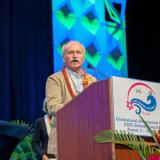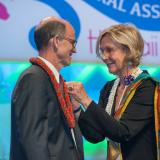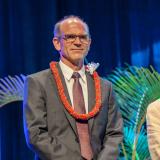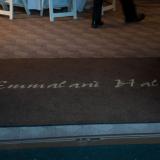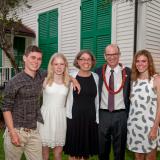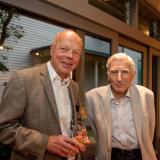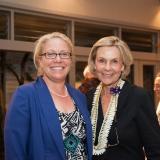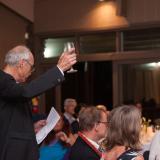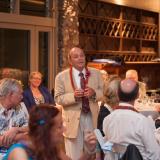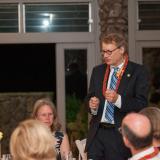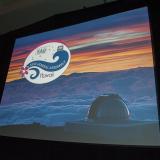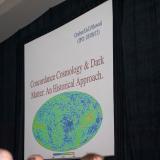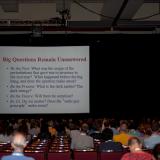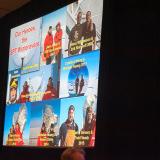2015 Gruber Cosmology Prize
In the call-and-response manner of modern science, the theoretical work of Jeremiah P. Ostriker and the leadership in the design and execution of observations of the universe’s relic radiation by John E. Carlstrom and Lyman A. Page, Jr., have contributed to, clarified, and advanced a new model of the universe—one that is part dark matter, part regular matter, and part dark energy, and was wholly powered by a primordial hyper-expansion of space called inflation.
2015 Cosmology Prize Recipients
Laureate Profile
The 2015 Gruber Prize in Cosmology honors theorist Jeremiah P. Ostriker for his lifetime of achievements and the experimentalists John E. Carlstrom and Lyman A. Page, Jr., for their pioneering observations of the cosmic microwave background (CMB), the relic radiation from the infancy of the universe’s existence. Individually and collectively the works of these three scientists has helped to establish and advance the standard cosmological model: a universe that arose out of an inconceivably dense state of matter and energy, and has been expanding and cooling ever since, eventually coalescing into today’s familiar skyscape of planets, stars, and galaxies.
During a five-decade career at Princeton University, Jeremiah Ostriker has made significant contributions to the studies of galaxy formation, the interstellar medium, and the intergalactic medium. He has also repeatedly challenged assumptions about how the universe works and proposed radical alternative interpretations. In 1972 he and Princeton colleague P. James E. Peebles created computer simulations that indicated either Newton’s law of gravitation is wrong or some sort of invisible mass must be present to stabilize rotating spiral galaxies such as our own Milky Way. A year later, in collaboration with a postdoctoral fellow, Ostriker and Peebles surveyed existing data from a wide array of observations of individual galaxies and clusters of galaxies and concluded, in the opening sentence of a now-classic paper: “There are reasons, increasing in number and quality, to believe that the mass of ordinary galaxies may have been underestimated by a factor of 10 or more.”
In 1995, Ostriker and another Princeton colleague, Paul J. Steinhardt, argued that the total amount of matter in the universe, dark or otherwise, is at odds with some key theoretical implications of the Big Bang interpretation of the universe. Ostriker and Steinhardt invoked yet another mysterious missing component that they said should be permeating the universe.
Today we call the missing components that Ostriker proposed in the 1970s and 1990s dark matter and dark energy, respectively—abstract ideas that have been borne out by innumerable observations. In fact, while other theorists were making arguments similar to that of Ostriker and Steinhardt in the mid-1990s, what distinguishes their paper is the suggestion that this component should contribute about 70 percent to the total mass and energy of the universe—a figure validated by many later observations, including those made by the instruments overseen by Carlstrom and Page.
While both Page and Carlstrom have worked extensively in the study of the CMB, they lead two projects in particular. Carlstrom, who has been at the University of Chicago since 1995, is the principal investigator on the South Pole Telescope, which was constructed at the U. S. science station at the Pole in late 2006 and early 2007. Page, who has been at Princeton since 1990, serves in the same capacity for the Atacama Cosmology Telescope, which was constructed on Cerro Toco in the mountainous Atacama Desert in Chile in 2007.
Those instruments, both still active, probe the CMB, the relic radiation dating to the infancy of the cosmos. When the universe was 380,000 years old it had cooled enough for hydrogen atoms and photons to decouple and go their separate ways. That “flashbulb” moment has survived as a sort of snapshot—a “baby picture” of the universe—though over the past 13.7 billion years the expansion of space has stretched the light from the image all the way into the microwave end of the electromagnetic spectrum. Look closely enough and finely enough at the CMB, though, and you should be able to see extraordinarily subtle shadings in temperature: the DNA for the galaxies, clusters of galaxies, and super-clusters of galaxies that populate the universe as we know it.
Among the many contributions to cosmology that the South Pole Telescope and the Atacama Cosmology Telescope have made are: the discovery of hundreds of clusters of galaxies going back to when the universe was about one-third its present age, providing a history of the growth of the large-scale structure of the universe; independent verification that the universe consists of approximately 25 percent dark matter, 70 percent dark energy, and 5 percent atoms; and strong evidence that the structure in the CMB is a remnant of quantum fluctuations. This latter data is in excellent agreement with the model of inflation, a theoretical primordial hyper-expansion of space that would have determined the distribution of all that energy and matter.
What is dark matter? What is dark energy? How to explain a quantum universe? In honoring Carlstrom, Ostriker, and Page, the 2015 Gruber Cosmology Prize recognizes science doing what science does best: answering fundamental questions while opening new frontiers for observers and theorists alike and raising new fundamental questions to puzzle us.
Citation
The Gruber Foundation proudly presents the 2015 Cosmology Prize to Jeremiah P. Ostriker for wide‐ranging theoretical work over 50 years, which has clarified our understanding of galactic structure and evolution, dark matter, the intergalactic medium and high energy astrophysics; and to John Carlstrom and Lyman Page for their leadership in ground‐based observational CMB cosmology, including instrumentation: from TOCO and DASI to the South Pole Telescope and the Atacama Cosmology Telescope.












